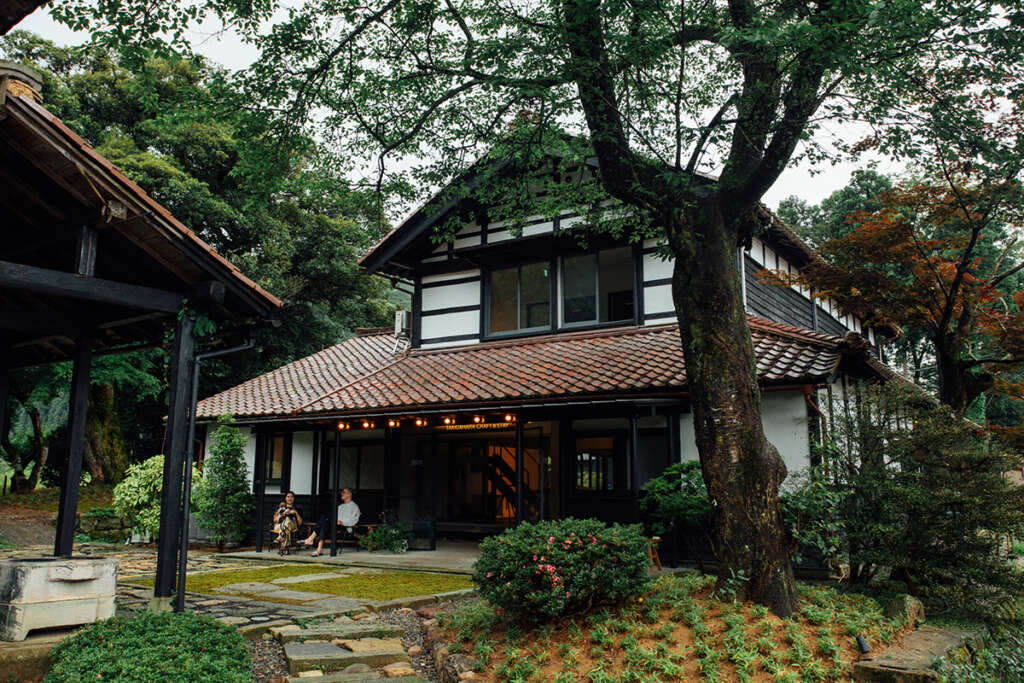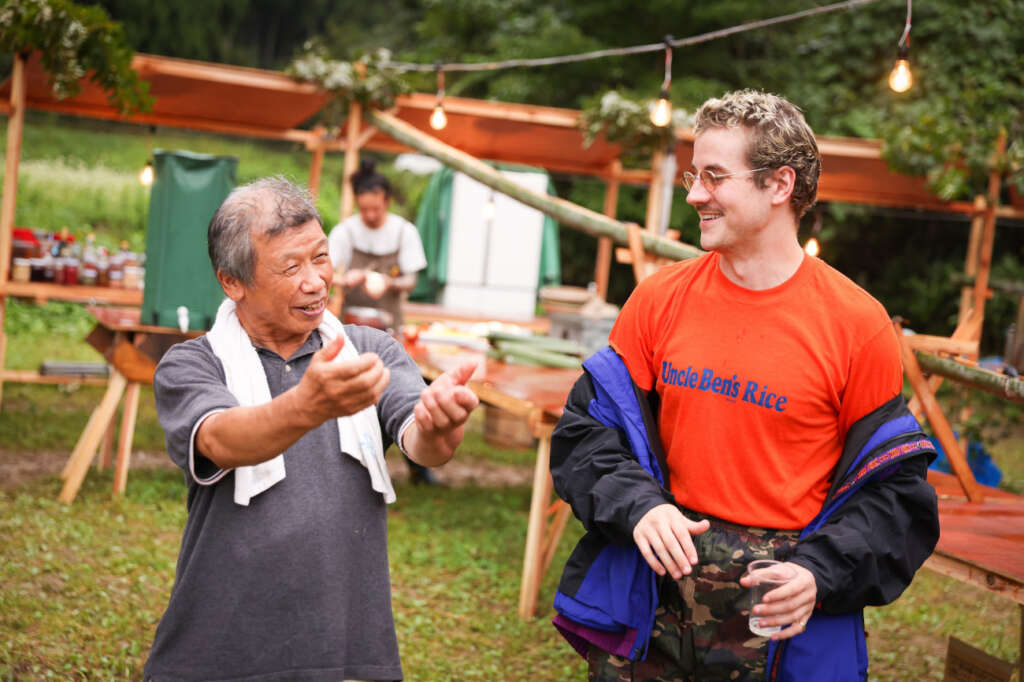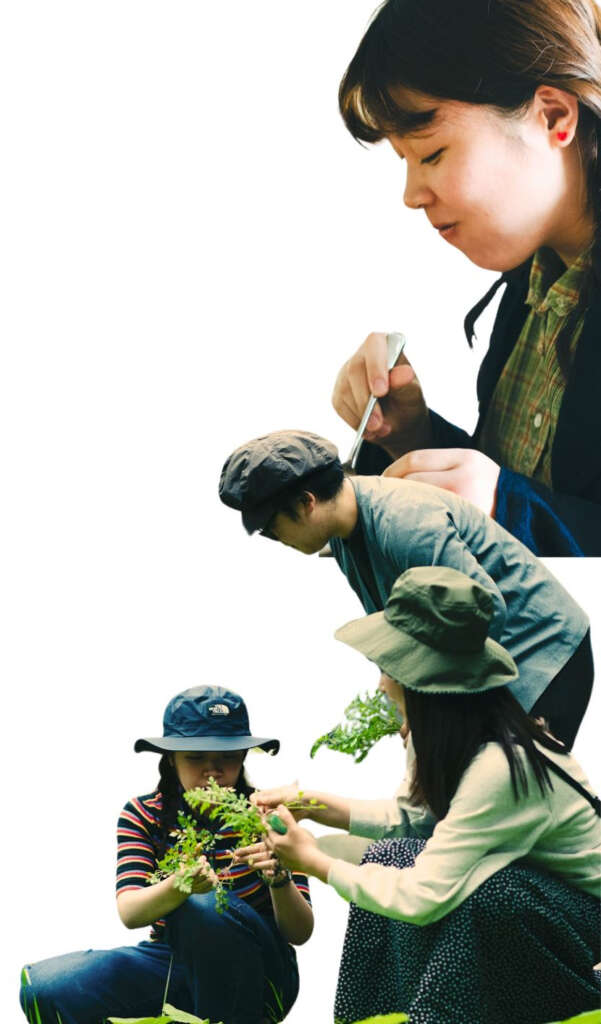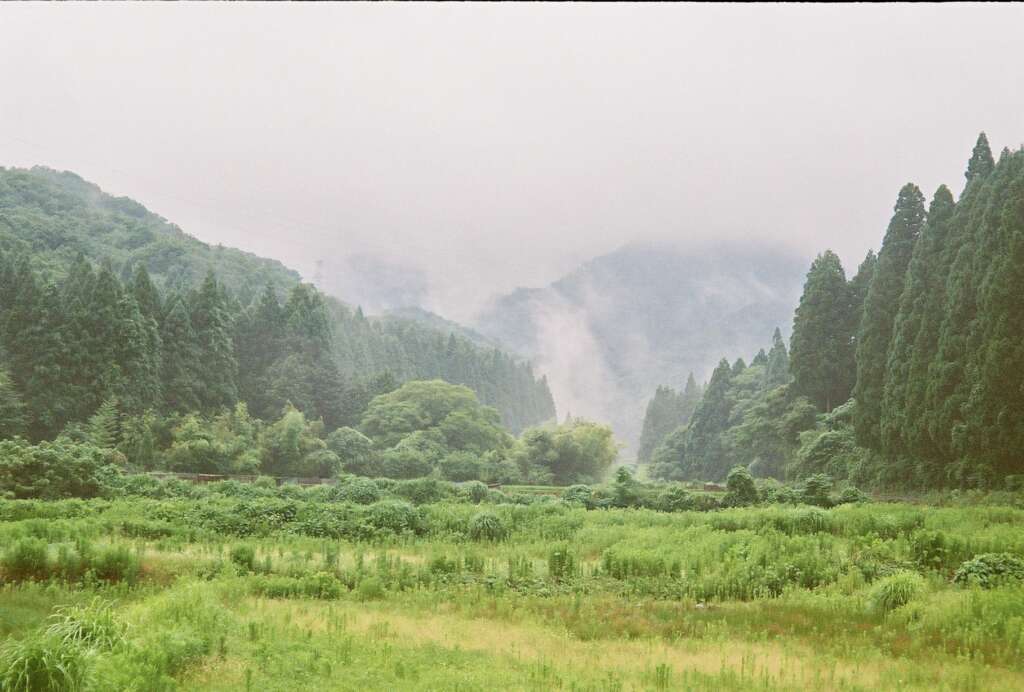Bessō Takigahara
Foraging, Fermenting + Seasonal Cooking
An edible retreat in rural Japan
Location
Takigahara, Japan
Dates
August 10 – 19, 2024
Cost
$2400USD
This program is an insight into the source of our food and an opportunity to learn from the symbiotic relationship that exists between humans, the land and the sea in Takigaraha village.


Description
Spend 10 days living in step with the edible landscape of Takigahara: a rural community in Japan where people coexist with nature, and neither the mountains nor the long culture of food cultivation has moved for centuries.
From chopsticks to salt to ingredients to plate, together we will build a meal from our surroundings – carving bamboo, harvesting seawater, foraging edible plants, fermenting, and embracing the practice of seasonal cooking.
Held in a locally-owned and beautifully restored Japanese farmhouse nestled at the foot of Kurakake yama, this program provides an opportunity to embrace sustainable ways of living with nature and others.
Farm-to-table breakfasts and chef-cooked dinners will be provided most days, and guests will be sleeping in shared accommodation in a space that has been furnished by some of the greats in contemporary design, including Zaha Hadid, Achille Castiglioni, Eero Saarinen and Jasper Morrison. As well as communal dining and relaxing areas, Takigahara Farm has a co-working and workshop space, an on-site café and a natural wine bar.
Conversational Japanese language and culture classes will also be a component of this program so that we can respectfully greet villagers, ask for directions when we want to dip in the river, and exclaim how lovely the forest is.
16 places only.



Satoumi + Satoyama
In the Japanese language, sato (里) means village, umi (海) means ocean and yama (山) means mountain.
Over thousands of years, the harmonious coexistence of people and nature in parts of Japan has created irreplaceable ecosystems that are deeply intertwined with human well-being and biological diversity: satoumi (sea villages) and satoyama (mountain villages).
Ishikawa – the scenic and fertile prefecture Takigahara is located in – is home to both, giving way to a mosaic of terrain: mountain, forest, sea and flatland.
In practising and preserving these precious ecosystems, villagers maintain a deep and interdependent connection with the land and the sea: growing rice and vegetables, farming chickens, foraging edible wild plants, hunting boar, harvesting salt, fishing in moderation and tending to seagrass beds.
In 2015, Japanese designer Teruo Kurosaki visited Takigahara to investigate its moss gardens. As well as a charming village with a rich spirit and dwindling population, Kurosaki-san found an abandoned farmhouse – which he then renovated, furnished and transformed into a community space.
“It is my hope,” Kurosaki-san explains, “that other cities and people will hear this and come here to learn. Then it becomes a kind of movement, a new type of village for the future.”
In contemplating a sustainable tomorrow on a liveable planet, we believe there is so much knowledge to glean from Takigahara village and satoumi-satoyama lifestyle: from the value of seasonal eating to an awareness that mutually-beneficial relationships can, do and must exist between humans and the natural world.
This philosophy is especially true for those of us who live in urban and suburban environments where connections like this have largely been severed.



Inclusions
Return pick up from local train station or airport
9 x nights shared accommodation at Takigahara farm
9 x breakfasts
8 x dinners (7 chef cooked and one meal we will cook together for ourselves)
5 x Japanese language and cultural classes
Bamboo chopstick-making workshop
Salt making field trip at Kurosaki beach
Shio koji workshop
Foraging field trip
Summer vegetable cooking workshop
Guided hike to the top of Mt Kurakake
Journalling + creative non-fiction writing workshop
Note that one dinner and all lunches will be self-funded. Takigahara Café is located on site, and everything on their menu is assembled from vegetables grown in local soil.


Program Schedule
Day 1: yōkoso | welcome
Afternoon arrival in Takigahara
Evening barbeque with villagers
Day 2: ohashi | chopsticks
Farm-to-table breakfast at Craft and Stay
Bamboo chopstick-making:
With bamboo artist Nari-san from Kanazawa, we will make our own chopsticks from freshly-cut bamboo harvested from Takigahara’s forest.
Japanese language and culture class with Megumi
Chef-cooked dinner (tamago | egg)

Day 3: shio | salt
Farm-to-table breakfast at Craft and Stay
Salt making at Kurosaki beach
Guided by Anna, we will forage sea water at Kurosaki beach and learn to make salt with which to cook.
Lunch at Irinoya beach house (self-funded)
Shin-chan is a diver who runs a beautiful restaurant on the beach, cooking and selling his catch at lunchtime. Here we will get the opportunity to meet him and sample his wares.
Chef-cooked dinner (sakana | fish)


Day 4: shio koji | ferment and traditional seasoning
Farm-to-table breakfast at Craft and Stay
Shio koji workshop
Food education designer Anna will show us how to make the traditional Japanese fermented seasoning shio koji using an ancient fungus called koji and the salt we foraged. We will also be making the sweet rice drink amazake.
Japanese language and culture class with Megumi
Chef-cooked dinner (niku | meat)
Day 5: kyūsoku | rest
Farm-to-table breakfast at Craft and Stay
Dinner in town (self funded)
Day 6: yama | mountain
Farm-to-table breakfast at Craft and Stay
Japanese language and culture class with Megumi
Hike Kurakakeyama
Gemma will coordinate a hike to the top of Kurakakeyama, followed by a refreshing dip in the river.
Chef-cooked dinner (yasai | vegetable)



Day 7: yasou | wild plants
Farm-to-table breakfast at Craft and Stay
Foraging field trip
Anna will guide an instructional foraging walk around the roads, fields and forests of Takigahara village, teaching about the edible plants that grow in the region and how to harvest them.
Chef-cooked dinner (tofu | tofu)
Day 8: natsu no aji | taste of summer
Farm-to-table breakfast at Craft and Stay
Japanese language and culture class with Megumi
Summer vegetable cooking workshop
Using a pantry of local ingredients and our fermented condiments, we will prepare a seasonal meal under the guidance of Anna – learning to cook based on principles and food characteristics rather than fixed recipes.
Summer bonanza: sharing the meal we have built

Day 9: hansei | reflections
Farm-to-table breakfast at Craft and Stay
Japanese language and culture class with Megumi
Writing workshop
Gemma will facilitate a discussion and writing workshop centred on place-based, creative non-fiction as a journalling practice.
Chef-cooked dinner (piza | pizza)
Day 10: ja ne | goodbye
Farm-to-table breakfast at Craft and Stay
11am check out


Accommodation
For the duration of our time in the village, we will be housed in Takigahara’s Craft & Stay facilities, which are the central nervous system of the farm. This 130-year-old double-storey house has been renovated for modern comfort and is a space where traditional art informs contemporary design choices.
Roomy, high ceilinged and made with original farmhouse timbers, the guest bedroom is located on the second floor—housing 16 bunk beds. Each bed comes with a curtain partition for privacy. If guests would like to request a private room, this can be discussed with the program leaders and depends on availability.
Guests are welcome to roam the open land, hike the mountains and swim in the nearby streams, which are all shared with the people of Takigahara Village. Within the farm grounds also sits a natural wine bar, open to all. Then there’s Takigahara Cafe: a local eatery selling lunch, light meals, coffee and drinks throughout the day; it’s an unofficial community centre and a great place to meet and chat with locals.


Location + Getting There
Takigahara Craft & Stay is located on Takigahara Farm, at O-66 Takigahara, Komatsu-shi, Ishikawa Prefecture.
The nearest stations are JR Kaga Onsen Station (15 minutes’ drive) and JR Komatsu Station (30 minutes’ drive); the nearest airport is Komatsu Airport (30 minutes’ drive). Guests will need to make their own way to any of these pickup locations, and once you arrive, we’ll come and scoop you up!
All transport necessary for our scheduled activities will be facilitated and covered by the program.
Currently, the best way to reach Komatsu is by train or a flight from Tokyo.
Flight: Several airlines operate flights between Tokyo (Haneda Airport or Narita Airport) and Komatsu Airport (KMQ). Flight durations are relatively short – around 1 to 1.5 hours.
Train: Take the Hokuriku Shinkansen (bullet train) from Tokyo Station to Kagaonsen Station (closer to the farm) or Kanazawa Station (slightly further away). The journey takes approximately 2.5 to 3 hours.
Car: If you decide to drive, parking onsite is available; you can rent a car in Tokyo and take the Hokuriku Expressway to reach Komatsu. The journey by car will take roughly 6 to 8 hours, depending on traffic.


Hosts
Anna Grønkjær
Anna is a food education designer based in Takigahara Village, Ishikawa. Since moving to Japan from Denmark five years ago, she has been working with farmers, fishermen, chefs, fermenters and other food professionals to cultivate a learning space that investigates the connection between nature and meal. If you put your hand in her pocket, you are likely to find a pinecone or sprig of rosemary from a nearby bush.

Megumi Koiwai
Megumi Koiwai is a writer, Japanese language teacher and doer of lots of other things, based in Tokyo. She loves to bond with women and share stories. Megumi also enjoys reading and cooking, and is a sucker for an aperitivo. Her last meal will be a tomato based pasta, preferably a bolognese with fries if that’s not too much to ask!

Gemma Clarke
Gemma is a writer and the founding editor of Astray. Originally from Australia, she’s been living out of a suitcase for the last year or so. With a background in travel writing, investigative journalism and breakfast radio, Gemma is passionate about independent publishing, community building and gender-based violence prevention. In her free time, she enjoys walking, making playlists and scribbling illegibly in her journal from trains, cafés and bars.

Application Process
We are looking to assemble a diverse group of community-minded folk who wish to gain a deeper understanding of food provenance, re/connect with the natural world and travel in a way that is slow, respectful and sustainable.
At Astray, we are determined to foster a space that is safe and inclusive for all – meaning we do not tolerate any form of bigotry, discrimination, abuse, marginalisation or insulting behaviour on the grounds of gender, ethnicity, religion, background, skin colour, race, religious belief, job, sexuality, gender identity, socioeconomic class, caste, disability or age.
Interested applicants should fill in a contact form telling us a little about who they are and why they wish to participate in this program. We will endeavour to get back to you within three working days.
Bessō Takigahara
Foraging, Fermenting + Seasonal Cooking
An edible retreat in rural Japan
This program is an insight into the source of our food and an opportunity to learn from the symbiotic relationship that exists between humans, the land and the sea in Takigaraha village.
Location: Takigaraha, Japan
Dates: August 10 - 19, 2024
Cost: $2400USD

Spend 10 days living in step with the edible landscape of Takigahara: a rural community in Japan where people coexist with nature, and neither the mountains nor the long culture of food cultivation has moved for centuries.
From chopsticks to salt to ingredients to plate, together we will build a meal from our surroundings – carving bamboo, harvesting seawater, foraging edible plants, fermenting, and embracing the practice of seasonal cooking.

Over the course of 10 days, we will take part in a series of workshops, field trips and community hang-outs in Takigahara as we slowly craft a meal from its fertile surrounds.
Held in a locally-owned and beautifully restored Japanese farmhouse nestled at the foot of Kurakake yama, this program provides an opportunity to embrace sustainable ways of living with nature and others.
Farm-to-table breakfasts and chef-cooked dinners will be provided most days, and guests will be sleeping in shared accommodation in a space that has been furnished by some of the greats in contemporary design, including Zaha Hadid, Achille Castiglioni, Eero Saarinen and Jasper Morrison.
As well as communal dining and relaxing areas, Takigahara Farm has a co-working and workshop space, an on-site café and a natural wine bar.
Conversational Japanese language and culture classes will also be a component of this program so that we can respectfully greet villagers, ask for directions when we want to dip in the river, and exclaim how lovely the forest is.
16 places only.

In the Japanese language, sato (里) means village, umi (海) means ocean and yama (山) means mountain.
Over thousands of years, the harmonious coexistence of people and nature in parts of Japan has created irreplaceable ecosystems that are deeply intertwined with human well-being and biological diversity: satoumi (sea villages) and satoyama (mountain villages).
Ishikawa – the scenic and fertile prefecture Takigahara is located in – is home to both, giving way to a mosaic of terrain: mountain, forest, sea and flatland.
In practising and preserving these precious ecosystems, villagers maintain a deep and interdependent connection with the land and the sea: growing rice and vegetables, farming chickens, foraging edible wild plants, hunting boar, harvesting salt, fishing in moderation and tending to seagrass beds.
In 2015, Japanese designer Teruo Kurosaki visited Takigahara to investigate its moss gardens. As well as a charming village with a rich spirit and dwindling population, Kurosaki-san found an abandoned farmhouse – which he then renovated, furnished and transformed into a community space.
“It is my hope,” Kurosaki-san explains, “that other cities and people will hear this and come here to learn. Then it becomes a kind of movement, a new type of village for the future.”
In contemplating a sustainable tomorrow on a liveable planet, we believe there is so much knowledge to glean from Takigahara village and satoumi-satoyama lifestyle: from the value of seasonal eating to an awareness that mutually-beneficial relationships can, do and must exist between humans and the natural world.
This philosophy is especially true for those of us who live in urban and suburban environments where connections like this have largely been severed.

Return pick up from local train station or airport
9 x nights shared accommodation at Takigahara farm
9 x breakfasts
8 x dinners (7 chef cooked and one meal we will cook together for ourselves)
5 x Japanese language and cultural classes
Bamboo chopstick-making workshop
Salt making field trip at Kurosaki beach
Shio koji workshop
Foraging field trip
Summer vegetable cooking workshop
Guided hike to the top of Mt Kurakake
Journalling + creative non-fiction writing workshop
Note that one dinner and all lunches will be self-funded. Takigahara Café is located on site, and everything on their menu is assembled from vegetables grown in local soil.

Day 1: yōkoso | welcome
Afternoon arrival in Takigahara
Evening barbeque with villagers
Day 2: ohashi | chopsticks
Farm-to-table breakfast at Craft and Stay
Bamboo chopstick-making:
With bamboo artist Nari-san from Kanazawa, we will make our own chopsticks from freshly-cut bamboo harvested from Takigahara’s forest.
Japanese language and culture class with Megumi
Chef-cooked dinner (tamago | egg)
Day 3: shio | salt
Farm-to-table breakfast at Craft and Stay
Salt making at Kurosaki beach
Guided by Anna, we will forage sea water at Kurosaki beach and learn to make salt with which to cook.
Lunch at Irinoya beach house (self-funded)
Shin-chan is a diver who runs a beautiful restaurant on the beach, cooking and selling his catch at lunchtime. Here we will get the opportunity to meet him and sample his wares.
Chef-cooked dinner (sakana | fish)
Day 4: shio koji | ferment and traditional seasoning
Farm-to-table breakfast at Craft and Stay
Shio koji workshop
Food education designer Anna will show us how to make the traditional Japanese fermented seasoning shio koji using an ancient fungus called koji and the salt we foraged. We will also be making the sweet rice drink amazake.
Japanese language and culture class with Megumi
Chef-cooked dinner (niku | meat)
Day 5: kyūsoku | rest
Farm-to-table breakfast at Craft and Stay
Dinner in town (self-funded)
Day 6: yama | mountain
Farm-to-table breakfast at Craft and Stay
Japanese language and culture class with Megumi
Hike Kurakakeyama
Gemma will coordinate a hike to the top of Kurakakeyama, followed by a refreshing dip in the river.
Chef-cooked dinner (yasai | vegetable)
Day 7: yasou | wild plants
Farm-to-table breakfast at Craft and Stay
Foraging field trip
Anna will guide an instructional foraging walk around the roads, fields and forests of Takigahara village, teaching about the edible plants that grow in the region and how to harvest them.
Chef-cooked dinner (tofu | tofu)
Day 8: natsu no aji | taste of summer
Farm-to-table breakfast at Craft and Stay
Japanese language and culture class with Megumi
Summer vegetable cooking workshop
Using a pantry of local ingredients and our fermented condiments, we will prepare a seasonal meal under the guidance of Anna – learning to cook based on principles and food characteristics rather than fixed recipes.
Summer bonanza: sharing the meal we have built
Day 9: hansei | reflections
Farm-to-table breakfast at Craft and Stay
Japanese language and culture class with Megumi
Writing workshop
Gemma will facilitate a discussion and writing workshop centred on place-based, creative non-fiction as a journalling practice.
Chef-cooked dinner (piza | pizza)
Day 10: ja ne | goodbye
Farm-to-table breakfast at Craft and Stay
11am check out

For the duration of our time in the village, we will be housed in Takigahara’s Craft & Stay facilities, which are the central nervous system of the farm. This 130-year-old double-storey house has been renovated for modern comfort and is a space where traditional art informs contemporary design choices.
Roomy, high ceilinged and made with original farmhouse timbers, the guest bedroom is located on the second floor—housing 16 bunk beds. Each bed comes with a curtain partition for privacy. If guests would like to request a private room, this can be discussed with the program leaders and depends on availability.
Guests are welcome to roam the open land, hike the mountains and swim in the nearby streams, which are all shared with the people of Takigahara Village. Within the farm grounds also sits a natural wine bar, open to all. Then there’s Takigahara Cafe: a local eatery selling lunch, light meals, coffee and drinks throughout the day; it’s an unofficial community centre and a great place to meet and chat with locals.

Takigahara Craft & Stay is located on Takigahara Farm, at O-66 Takigahara, Komatsu-shi, Ishikawa Prefecture.
The nearest stations are JR Kaga Onsen Station (15 minutes’ drive) and JR Komatsu Station (30 minutes’ drive); the nearest airport is Komatsu Airport (30 minutes’ drive). Guests will need to make their own way to any of these pickup locations, and once you arrive, we’ll come and scoop you up!
All transport necessary for our scheduled activities will be facilitated and covered by the program.
Currently, the best way to reach Komatsu is by train or a flight from Tokyo.
Flight: Several airlines operate flights between Tokyo (Haneda Airport or Narita Airport) and Komatsu Airport (KMQ). Flight durations are relatively short – around 1 to 1.5 hours.
Train: Take the Hokuriku Shinkansen (bullet train) from Tokyo Station to Kagaonsen Station (closer to the farm) or Kanazawa Station (slightly further away). The journey takes approximately 2.5 to 3 hours.
Car: If you decide to drive, parking onsite is available; you can rent a car in Tokyo and take the Hokuriku Expressway to reach Komatsu. The journey by car will take roughly 6 to 8 hours, depending on traffic.
Anna Grønkjær
Anna is a food education designer based in Takigahara Village, Ishikawa. Since moving to Japan from Denmark five years ago, she has been working with farmers, fishermen, chefs, fermenters and other food professionals to cultivate a learning space that investigates the connection between nature and meal. If you put your hand in her pocket, you are likely to find a pinecone or sprig of rosemary from a nearby bush.

Megumi Koiwai
Megumi Koiwai is a writer, Japanese language teacher and doer of lots of other things, based in Tokyo. She loves to bond with women and share stories. Megumi also enjoys reading and cooking, and is a sucker for an aperitivo. Her last meal will be a tomato based pasta, preferably a bolognese with fries if that’s not too much to ask!

Gemma Clarke
Gemma is the founder of Astray, an editor and a freelance writer. Originally from Australia, she’s been living out of a suitcase for the last year or so. With a background in travel writing, investigative journalism and breakfast radio, Gemma is passionate about independent publishing, community building and gender-based violence prevention. In her free time, she enjoys walking, making playlists and scribbling illegibly in her journal from trains, cafés and bars.


We are looking to assemble a diverse group of community-minded folk who wish to gain a deeper understanding of food provenance, re/connect with the natural world and travel in a way that is slow, respectful and sustainable.
At Astray, we are determined to foster a space that is safe and inclusive for all – meaning we do not tolerate any form of bigotry, discrimination, abuse, marginalisation or insulting behaviour on the grounds of gender, ethnicity, religion, background, skin colour, religious belief, sexuality, gender identity, socioeconomic class, caste, disability or age.
Interested applicants should fill in a contact form telling us a little about who they are and why they wish to participate in this program. We will endeavour to get back to you within three working days.

